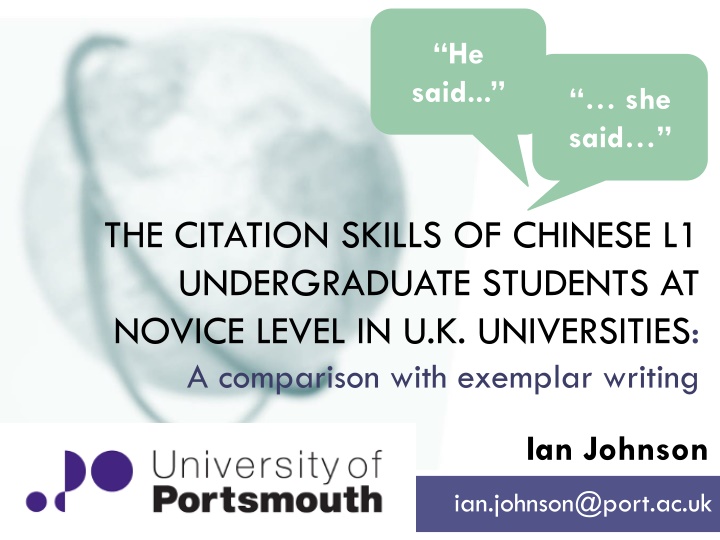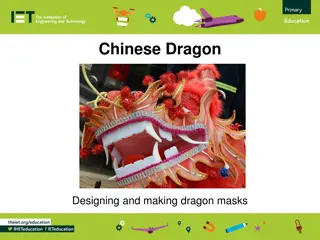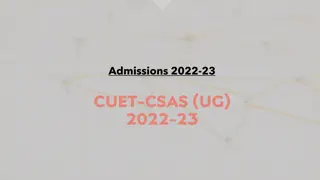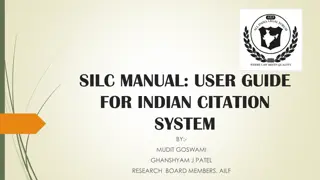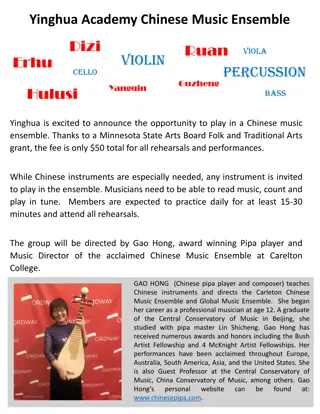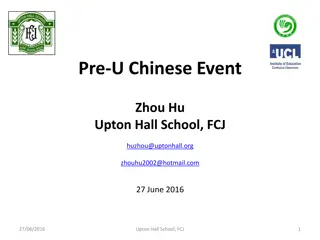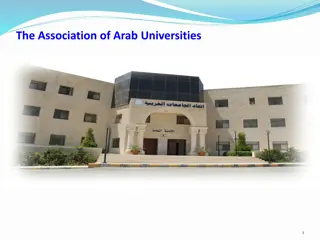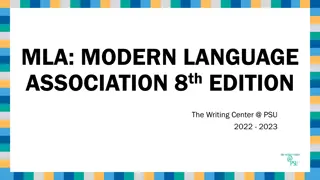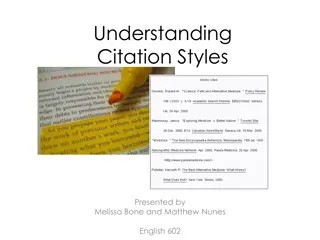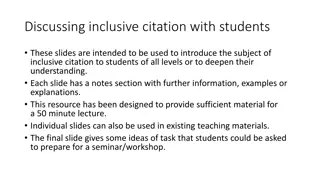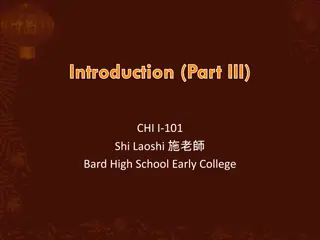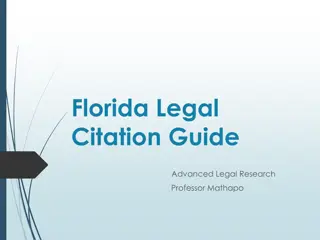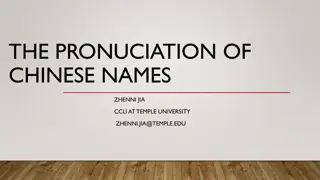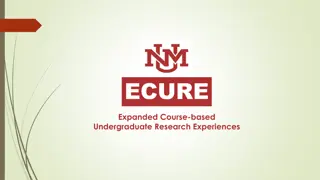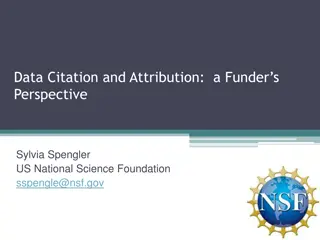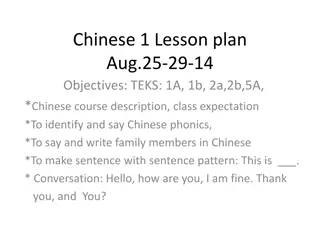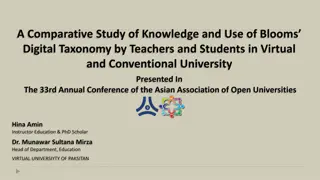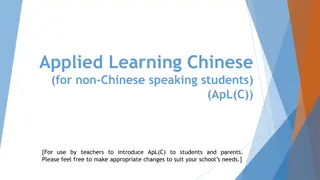Comparison of Citation Skills in Chinese L1 Undergraduate Students at Novice Level in U.K. Universities
The study explores the citation skills of Chinese L1 undergraduate students at novice level in U.K. universities compared to exemplar writing. It addresses the significance of citation in academic writing, the research gap in this area, aims to understand the divergence in citation practices, linguistic variations in reporting verb usage, and implications. The study delves into the multifaceted nature of citation, particularly focusing on reporting verbs, writer engagement with cited authors, and the challenges in identifying non-native speakers' viewpoints towards citations.
Download Presentation

Please find below an Image/Link to download the presentation.
The content on the website is provided AS IS for your information and personal use only. It may not be sold, licensed, or shared on other websites without obtaining consent from the author.If you encounter any issues during the download, it is possible that the publisher has removed the file from their server.
You are allowed to download the files provided on this website for personal or commercial use, subject to the condition that they are used lawfully. All files are the property of their respective owners.
The content on the website is provided AS IS for your information and personal use only. It may not be sold, licensed, or shared on other websites without obtaining consent from the author.
E N D
Presentation Transcript
He said... she said THE CITATION SKILLS OF CHINESE L1 UNDERGRADUATE STUDENTS AT NOVICE LEVEL IN U.K. UNIVERSITIES: A comparison with exemplar writing Ian Johnson ian.johnson@port.ac.uk
Rationale Significance of group China contributed 25% (58,800) of U.K. international undergraduates in 2014-15 (HESA, 2015). Citation is key to dialogic (Bakhtin, 1981) writing, which: requires students to argue; [ ] make a contribution to current debates by adding their voices to the ongoing academic conversation, and in doing so claim membership of the discourse community (Groom, 2000, p.66). Research gap Findings on undergraduate citation are rare despite extensive analysis on academic journals (e.g. Hyland, 1999; Bloch, 2010) and post-graduates(e.g. Petri , 2007; Petri & Harwood, 2013)
Aims Using a corpus-based approach and with writing sampled from students with Chinese L1, attending pre- sessional English for Academic Purposes courses in U.K: To what extent do citation practices diverge from proficient exemplar writing? How is any such variation linguistically realised in terms of reporting verb usage? What implications arise?
Choice of variable Citation multifaceted: 19 (linked) student targets (Pecorari, 2013). Present study examined five component aspects of citation: reporting verbs chosen for deeper analysis. Reporting verbs extensively analysed (Thompson & Ye, 1991) and quantifiable / open to influence (Bloch, 2010). Prior research (Hyland 1999; Nesi 2014) matches in showing argue and suggestat highest frequencies in Social Sciences.
Reporting verbs and argument Compare, in turns of writer engagement with cited author: Information prominent citation The Earth is flat (Smith, 2010) Author prominent citation Smith (2010) believes that the Earth is flat
Writers stance It is a common experience for EAP teachers to have great difficulty in identifying the point of view that a non-native speaker is trying to convey towards cited authors, or even to assume [ ] that a certain point of view is being conveyed, only to find this view unexpectedly contradicted in a subsequent explicit evaluation (Thompson & Ye, 1991, p.366) Citation methods, including reporting verb choice, expand or contract the dialogic space for alternatives (Martin & White, 2005).
Wider considerations Consideration Citation has linguistic, epistemological and social dimensions. Treatment Validity of all considerations fully acknowledged. Corpus-based methods afford only linguistic explanations. Epistemological dimension requires separate research and teaching. Present work alights on textual plagiarism, a part of the wider spectrum. Poor citation = Plagiarism , but no Mandarin translation for plagiarism (Liu, 2005). Ethical contention regarding normative Western conventions (Pennycook, 1996). Plagiarism as Prototypical (cheating) versus Textual (developmental) (Pecorari, 2013).
Sample Analogue corpus 178 draft essays, on sociological topics Produced six weeks after arrival in U.K; L1 Chinese 207,000 word tokens Exemplar / Reference corpus Social Sciences sub corpus of BAWE 1,999,130 word tokens Previously analysed (Nesi, 2014) for citation: model
Methodology Chinese Learner English (CLE) corpus andBAWE Social Sciences (BAWESS) compared in Sketch Engine Corpus Query Language (CQL) adapted from Nesi (2014) CQL analysis triangulated with manual corpus checks Reporting verb tokens extracted from both corpora and normalised per 500,000 words Log Likelihood values (Dunning, 1993) calculated (Rayson, 2015) for statistical keynessof each reporting verb
Corpus Query Language Additional capture Original (Nesi, 2014) [tag = "NP.?"] [word = "et"]? [word = "\."]? [word = "al"]? [word = "\."]? [word = "\("] [tag = "CD"] [word = "\)"] [tag = "VV|VO|VVD|VVZ|MD"] Present Perfect tense: X has said Follow-on citations: X also said Modified to: [tag = "NP.?"] [word = "et"]? [word = "\."]? [word = "al"]? [word = "\."]? [word = "\("] [tag = "CD.?"] [] {0,3} [word = "\)"]? [tag = "VV.*|MD|VH.*"] Irregular novice citations X, he said Sufficiency question: NoCQL discovered all citation attempts
Results Reporting verb tokens per 500k words Corpus Types Tokens CLE (analogue) BAWESS (exemplar) 33 168 405 186 1297 324 Narrower but deeper usage of reporting verbs in the novice corpus.
What may affect reporting verb selection? Novicemotivations variously viewed as: often random (Pecorari, 2008) display of lexical variation (Bloch, 2010) display of literature consultation (Nesi, 2014) L1 cultural factors Lexical priming (Hoey, 2005) Knowledge transfer customs (Hu & Lei, 2013) Act type reported (Thompson & Ye, 1991; Charles, 2006) Research (find/show) , Mental (think) or Textual (argue)
Lexical breakdown Normalised frequencies of reporting verbs 120 100 Frequency per 500k words 80 60 40 20 0 say show find mention claim state argue suggest explain believe Reporting verb Freq p/500k CLE Freq p/500k BAWE S/S
Keyness values Reporting Verb Say Show Find Mention Claim Argue Suggest Explain Believe Log Likelihood (keyness) ****106.65 ****36.61 ***12.33 **10.12 **7.1 3.35 *4.14 *4.82 **6.86 Black Key in CLE Red Key in BAWESS
Implications Say probably acting as na ve substitute clear surface meaning; little rhetorical purpose (Pickard, 1995) ShowandFind frequency in novice writing indicative of lack of alternatives Endorsing effect on claims, especially show (Lee, 2010) ClaimandMention Relatively more frequent among novices (frequency accuracy) Why? Possibility of lexical priming or desire for lexical variation. Argue, Suggestand Believe reduced incidence contracts space for alternatives (Lee, 2010)
Act type reported % of reporting verb tokens in CLE % of reporting verb tokens in BAWESS Act type Research Mental Textual 21.3 1.2 77.5 21.2 9.7 69.1 Novices reported fewer acts as thoughts and more as locutions In tandem with previously explained results: Reduce perceived distance between author and writer Dialogic contraction Claims reported as if accepted wisdom / givens
Pedagogically speaking Across CLE, a 5% average mark increase for essays with five report verb clauses versus one. Analogue and exemplar corpora: potential for developing student writing (Thompson & Tribble, 2001). Gardner and Nesi (2013): BAWE corpus-based citation resources on British Council website. Should the focus be on teaching usage of a small range of key report verbs? Can a corpus activity help?
The problem http://www.port.ac.uk/students/academic-skills-unit/
Degree of commitment High Low Believe Suggest Demonstrate Argue State Find Claim Show
Sample teaching activity 1. Identify the different verb forms of show; change each form to its own colour. 2. Look at each line after show. Highlight each grammatical structure in a different colour. 3. In red, identify any grammar errors and discuss the reasons why. 4. Put five new words into bold font. 5. If we show something, how definite do we feel about its truth?
Future directions Directions for pedagogy? Use of corpora, including learner corpora or Citation better developed by teaching students argumentation skills primarily verbally? Can the CQL limitations be overcome? How well would the results replicate for other nationalities?
References (1) Bakhtin, M. (1981). The dialogic imagination. Austin: University of Texas Press. Bloch, J. (2010). A concordance-based study of the use of reporting verbs as rhetorical devices in academic papers. Journal of Writing Research, 2(2), 219-244 Charles, M. (2006). Phraseological patterns in reporting clauses used in citation: A corpus- based study of theses in two disciplines. English for specific purposes 25(3), 310-331. Dunning, T. (1993). Accurate methods for the statistics of surprise and coincidence. Computational Linguistics 19(1), 61-74 Gardner, S. & Nesi, H. (2013). A classification of genre families in university student writing. Applied Linguistics, 34(1), 25-52 Groom, N. (2000). A workable balance : Self and sources in argumentative writing. In S. Mitchell & R.Andrews (Eds.) Learning to argue in higher education, (pp. 65-73). Portsmouth, NH: Boynton Cook HESA. (Higher Education Standards Authority) (2015). Students in Higher Education 2013-14 Hoey, M. (2005). Lexical Priming: a new theory of words and language. New York: Routledge. Hu, G. & Lei, J. (2012). Investigating Chinese university students knowledge of and attitudes toward plagiarism from an integrated perspective. Language Learning, 62(3), 813 850
References (2) Hyland, K. (1999). Academic attribution: Citation and the construction of disciplinary knowledge. Applied Linguistics, 20(3), 341-367 Lee, S-H. (2010). Attribution in high- and low- graded persuasive essays by tertiary students. Functions of Language, 17(2), 181-207. Hu, G. & Lei, J. (2012). Investigating Chinese university students knowledge of and attitudes toward plagiarism from an integrated perspective. Language Learning, 62(3), 813 850 Hyland, K. (1999). Academic attribution: Citation and the construction of disciplinary knowledge. Applied Linguistics, 20(3), 341-367 Lee, S-H. (2010). Attribution in high- and low- graded persuasive essays by tertiary students. Functions of Language, 17(2), 181-207. Liu, D. (2005). Plagiarism in ESL students: is cultural conditioning truly the major culprit? ELT journal, 59(3), 234-241 Martin, J.R & White, P.R.R. (2005). The language of evaluation. Basingstoke: Palgrave Nesi, H. (2014). Corpus Query Techniques for investigating citation in student assignments. In M. Gotti & D. Giannoni (eds.) Corpus analysis for descriptive and pedagogic purposes (pp. 85- 106). Bern: Peter Lang. Pecorari, D. (2008). Academic writing and plagiarism: A linguistic analysis. London: Continuum.
References (3) Pecorari, D. (2013). Teaching to avoid plagiarism: How to promote good source use. Maidenhead, UK: Open University Press. Pennycook, A. (1996). Borrowing others words: Text, ownership, memory and plagiarism. TESOL Quarterly, 30(2), 201-230 Petri , B. (2007). Rhetorical functions of citations in high- and low-rated master s theses. Journal of English for Academic Purposes, 6(3), 238 253. Petri , B. & Harwood, N. (2013). Task requirements, task representation, and self-reported citation functions: An exploratory study of a successful L2 student s writing. JEAP, 12(2), 104 124 Pickard, V. (1995). Citing previous writers: What can we say instead of say ? Hong Kong Papers in Linguistics and Language Teaching, 18(1995), 89-102 Rayson, P. (2015). Log-Likelihood and effect size calculator. University of Lancaster. Retrieved from Lancaster University website: http://ucrel.lancs.ac.uk/llwizard.html Thompson, G. & Ye, Y.Y. (1991). Evaluation in reporting verbs used in academic papers. Applied Linguistics, 12(4), 365-382. Thompson, P. & Tribble, C. (2001). Looking at citations: Using corpora in English for academic purposes. Language Learning & Technology, 5(3), 91-105.
